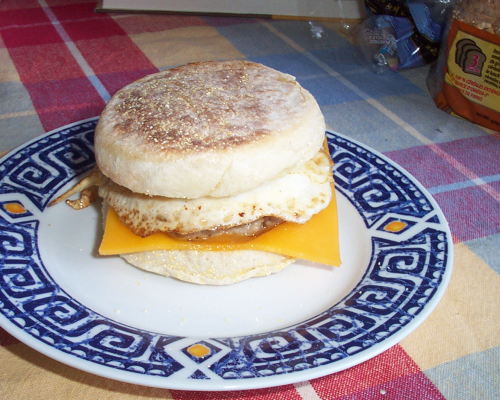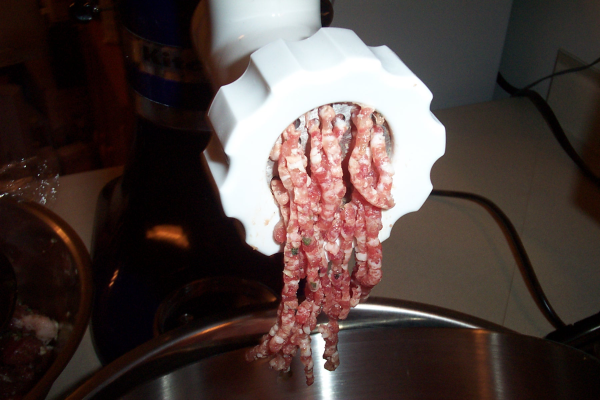This is not a sausage McMuffin

When I started this blog, one of my goals was to make my own sausage. In fact, part of the original inspiration for creating my own blog came from Michael Ruhlman and Brian Polcyn's book Charcuterie, which focuses on, though is not limited to, sausage in all its various forms. If you've read many of my previous entries, you may have noticed that this book is something of a theme for me. A touchstone, if you will.
There were a couple of obstacles to me making sausage at home, though. Chief among them was the fact that I didn't have a meat grinder. This problem was finally rectified in December, when my parents gave me the meat grinder attachment for the KitchenAid stand mixer as a birthday gift. Ever since I returned home, I've been dying to try it out, but didn't have a chance to do so until a couple of weeks ago. (OK, so it's taken me longer than planned to get this post up.) I was at the local farmers' market and managed to pick up a few pounds of pork butt, then hit the grocery store to grab all the other ingredients I needed to make my first batch of sausage.
I decided to go with the breakfast sausage for a couple of reasons: first, because Ruhlman explicitly states that it's easy. Second, because it didn't need to be put in casings and I didn't want to invest in a sausage stuffer right away. (Besides, I haven't found a local source for casings yet). And third, because it's a necessary ingredient in the breakfast food pictured above.
When I was growing up, it was always a major event to have more than cold cereal for breakfast. In fact, Christmas morning was the only day of the year we could be guaranteed a hot breakfast. Sure, there were other mornings - usually on the weekend - when Dad would make eggs and English muffins or we would head out to McDonald's, but these occasions were the exception, not the rule. When it did come to pass, though, sausage patties were always one of my favourite treats. I wanted to see if fresh ones were substantially better than the frozen-in-a-box variety.
 In Charcuterie, Ruhlman and Polcyn point out that sausage-making takes some time, so I was surprised how easy it all seemed. In fact, the most time-consuming step was boning and dicing the meat, though part of the time consumption stemmed from my worry that I wasn't trimming off enough of the connective tissue, which would jam the grinder. As it turned out, I only had to stop it once to untangle bits of sinew from the blade.
In Charcuterie, Ruhlman and Polcyn point out that sausage-making takes some time, so I was surprised how easy it all seemed. In fact, the most time-consuming step was boning and dicing the meat, though part of the time consumption stemmed from my worry that I wasn't trimming off enough of the connective tissue, which would jam the grinder. As it turned out, I only had to stop it once to untangle bits of sinew from the blade.I ended up with slightly less than the five pounds of meat the recipe calls for, but forged ahead anyway. After prepping all the seasonings, I mixed them in with the diced meat and left it all in the fridge overnight. The next evening, I ground the meat into the KitchenAid bowl set in ice, then added ice water to the ground mixture and mixed it with the paddle attachment, a step known as the "primary bind." (I did this in two batches, even though the book says that the KA can do it in one. Maybe they had a different model in mind?) A quickly fried test batch showed that the sausage was a little salty, but insanely delicious - definitely better than frozen.
Once I had made my first sausage muffin, pictured above, I portioned off the rest of the meat, flattened it into it patties, and froze it in anticipation of those mornings when I feel like having something a little special for breakfast. Then, I started flipping through the book to see what kind of sausage I'd be making next...

0 Comments:
Post a Comment
<< Home